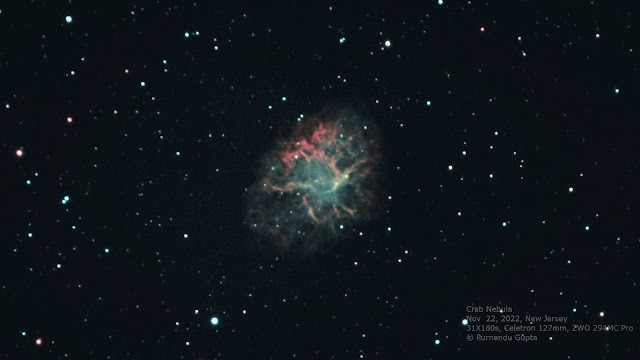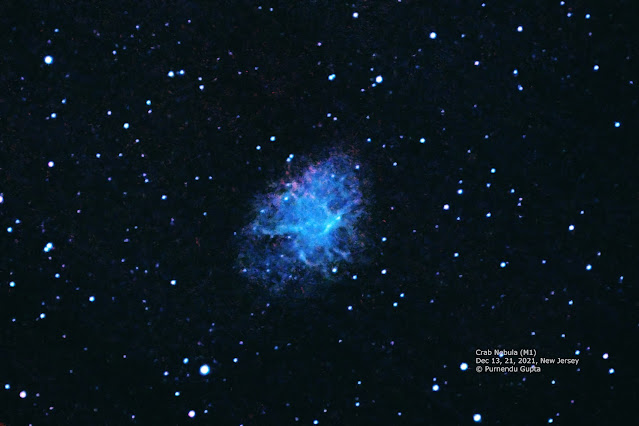 |
| Crab Nebula; Nov 22, 2022 |
The year was 1054. Emperor Renzong of the Song Dynasty reigned in China out of the capital city Kaifeng on the southern banks of the Yellow River. On the 4th of July, at the break of dawn, a bright star burst into view in the sky in the constellation of Taurus. It was so bright, it could be seen during daytime. It remained visible for 23 days during the day. The star faded slowly over time and on 6 April 1056, 642 days or nearly two years later it disappeared from view. The Chinese wrote about it, as did the Japanese and Arabic astronomers.
Today, a thousand years later, a tenuous wispy cloud is all that remains in place of the progenitor star, now known as the Crab Nebula or Supernova Remnant 1054.
 |
Simulated image of supernova SN 1054 at the position
of modern Crab Nebula, as presumably would have
|
Connecting the Dots
In 1758, seven hundred years after the event, French astronomer Charles Messier was searching for the predicted return of Halley's comet that year with his four inch telescope from his downtown Paris observing station. He noted this fuzzy object in Taurus which did not move across the stellar backdrop like comets should. To avoid future confusion, he put this down as the first item in his now famous catalog of non-comet distractions. Hence the Crab nebula is also known as Messier 1 or M1. |
| Edwin Hubble. Source: Encyclopedia Britannica |
This estimate was refined using spectroscopy in 1942 by Nicholas Mayall, a wannabe mining engineer turned astronomer at the Lick observatory in California and his collaborator Dutch radio astronomer Jan Oort by studying the Chinese historical records of the guest star more closely.
A curious quest that began in Chinese riverbanks completed a full circle a thousand years later at the American west coast, aided by a Frenchman and a Dutch along the way.
The Crab’s Beating Heart
 |
GFDL movie of the Crab Pulsar | Source=http://www.ast.cam.ac.uk/~optics/Lucky_Web_Site/ |Date=07 Aug 2007 | Author=Cambridge University Lucky Imaging Group |
At the center of the Crab nebula is a spinning, relatively young neutron star. This is the stellar core that remained after the nova blew out its outer layers. Relativistic X-Ray jets beam out of it, crossing paths with the earth 30 times every second as it spins. This is known as the Crab Pulsar.
A thousand years after creation, the Crab is still young at heart!
 |
This image is the largest image ever taken with Hubble Space Telescope and assembled from 24 individual exposures and is the highest resolution image of the entire Crab Nebula ever made. Source Hubble Space Telescope Images |
Imaging Evolution
 |
| Crab Nebula, Mar 18, 2020 |
The original picture to the left taken on March 18, 2020 used the same telescope and imaging camera but only short 30 second exposures, the maximum possible on my old altitude-azimuth style mount.
The second update which is now on the top of this page is a new image acquisition using the newly purchased dedicated astronomy camera, ZWO ASI 294MC Pro. The total integration time was about 90 mins with exposures being 31X180s. As one can see that while the capture time has come down by 30 mins (out of 2 hrs) - the image quality and color has significantly improved compared to the Dec 2021 image.
The difference increased exposure time can make with the same scope, is quite drastic. However the oldest image from 2020 is closest to what one would see visually through a mid size telescope.
Imaging Details (Dec 2021):
____________________________________________________
Crab Nebula, Dec 13, 21, 2021, New Jersey
Canon 70D
Day 1: 21 X 300s light, 10X dark, 23 Bias ISO 800
Day 2: 5 X 300s light, 5X dark, 5 Bias ISO 800
Celestron 127 mm Mak-Cass scope with 0.6X focal reducer
Celestron AVX mount, Orion 50mm guidescope and ZWO ASI 120 mm camera
CPWI, PHD2, NINA, Deep Sky Stacker, Topaz AI and GIMP

No comments:
Post a Comment